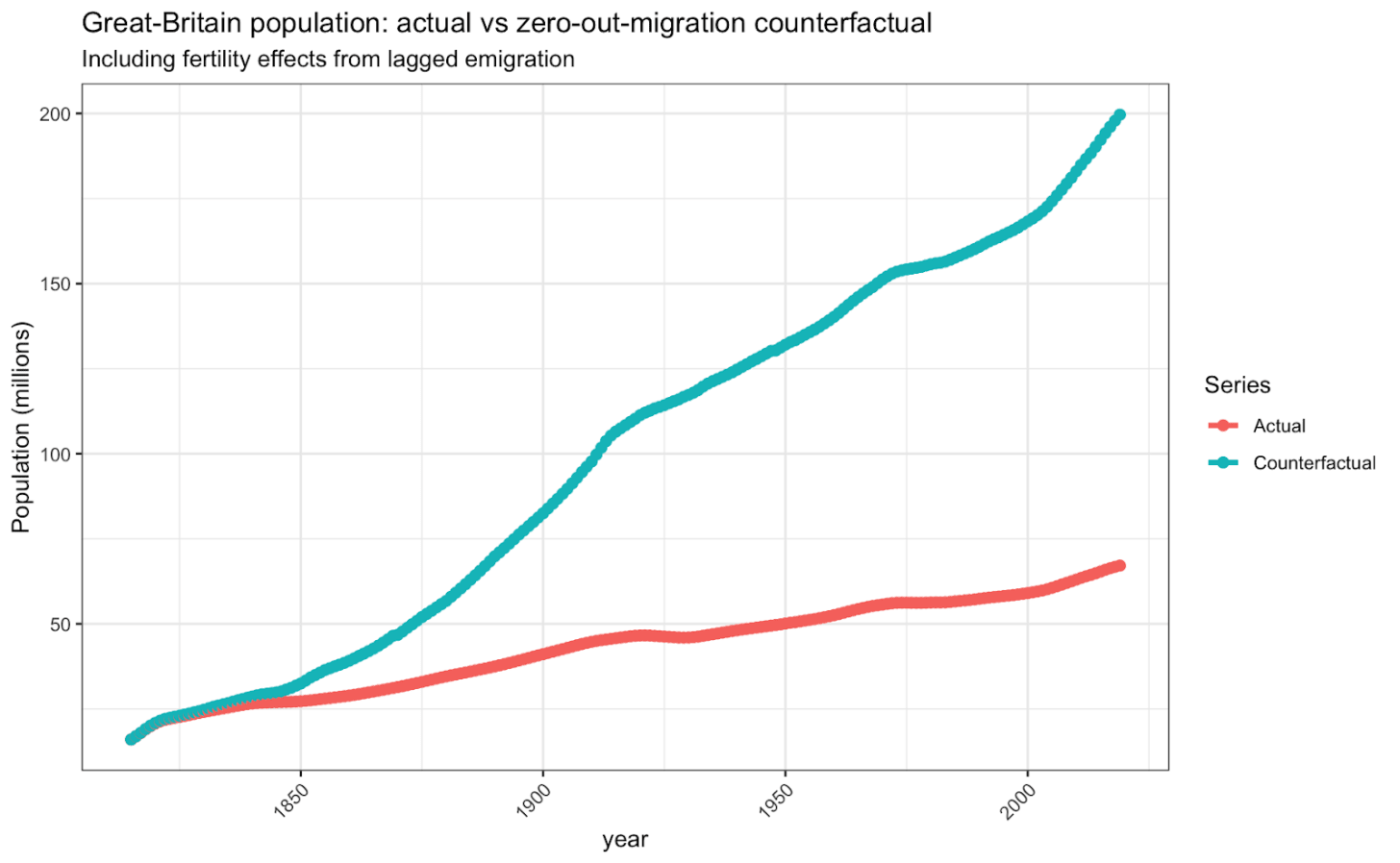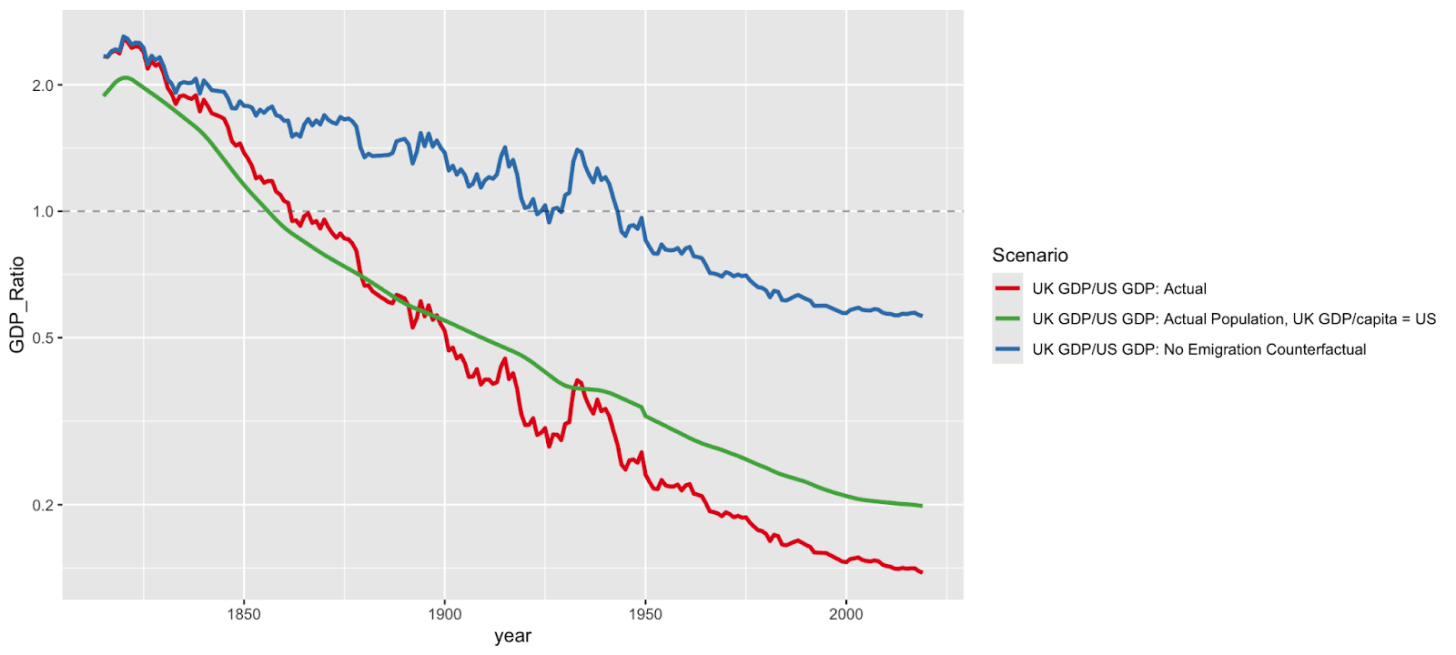Once an empire existed on which the sun did not set for over two centuries. Soon the sun will set because that country is paying £18bn to give away its last naval base in the Indian Ocean. What happened?
Britain’s slide from global hegemony to irrelevance wasn’t because it once had the world in GDP per capita, but is now doing famously badly relative to other developed countries. Income gaps among rich nations are modest, and weaker economies like the USSR (never above 43 % of US GDP per capita) still packed strategic punch. What shrank Britain’s weight was not low fertility either—its birth rates stayed high, at least until WW1—but mass emigration. The people, and the children they would have had, simply left.
Over the 19th century, UK emigration averaged 0.5% of the population per year. About half of migrants eventually went to the US, with the remainder primarily going to Canada, Australia, New Zealand, with smaller numbers going to various African colonies, primarily what is now South Africa. In this post, I model a counterfactual where emigration of British citizens was zero since 1815, and compute the corresponding UK population.
How can we estimate the population absent emigration? The naive solution—just add every emigrant back into the headcount—ignores the children those emigrants would have had. A cleaner method strips migration out of the growth rate itself: start with the observed population, subtract net migration each year as a share of the total, and let that adjusted growth rate compound forward. The result is a population path that implicitly assumes net migration is zero for the entire period.
The core emigration series was pieced together from A History of Emigration for 1815-1911 data, some 1920s Parliamentary questions on migration, a statistics handbook for 1948-1950, the post-1960 UK emigration records. Data for 1930-1947 was not readily available and was assumed to be zero for the sake of conservatism, and data for 1951-1960 was inferred from the net migration rate, meaning for both these periods actual outflows were likely notably higher. Data pre-1870 refers to every person who left via ports in Great Britain to emigrate to a long distance destination, and thus includes some individuals who transited through British ports for immigration purposes without being British themselves. Post-1870 data refers to British citizens only (or British subjects as they were known before 1949). Pre-1850 net migration was not available directly, and was imputed at 60% of the level of emigration, on the grounds that 40% of emigrants later permanently returned. All of Ireland is excluded from the data pre-1922, but post-1922 data includes Northern Ireland.
This methodology would imply a population of the UK today at slightly above 150mn. However, this ignores the potential effects of any emigration on fertility. Firstly, might there be some effect lowering the standard of living from the higher population, which could lower fertility? Under the classic Solow model of economic growth, this would occur, but not by much. The higher rate of population growth would depress the capital stock per capita - fewer machines per worker - reducing GDP per capita by about 4.7%. Substantial, but not large enough to interrupt this population boom in its tracks. Secondly, the higher population would enable larger scale effects for cities - about 4% per doubling per Duranton and Puga (2020). If this larger population was sorted into cities at exactly the current distribution of size, this would by now have more than counteracted this decline, although it would have reduced fertility in the interim, and is hence included. Additionally, a majority of migrants were male, causing a demographic imbalance in the UK - in 1850 there were 500k more women than men, implying 0.9% higher fertility in the 19th century without this (assuming monogamy).
Most of these effects are fairly small in magnitude however - adding up to a 5mn change in expected population. This is because the elasticity of fertility to income in the 18th century was fairly small - Klemp (2012) found 0.31 to wages, while Foreman-Peck (2015) found 0.13 and Clark (2007) found essentially zero - implying minimal changes in TFR given the already small changes in wages. 0.2 will be used here for the sake of conservativism.
The biggest upward revision comes from the emigrants’ own future families. Most left as adults: they had already survived the brutal childhood mortality of the 1800s, yet 80 % were still in the 15-50 age band, with the bulk clustering in their twenties. That means they carried more unspent fertility than the average Briton at home. Adjusting the model for this higher expected childbearing (and noting that our lack of fine-grained age data likely understates the gap) pushes the population trajectory to the higher line shown in the next figure.

With the fertility boost included, Britain would now house just over 200 million people instead of 70 million. How would that reshape the Anglo-American balance? The chart below offers a clue—though it likely understates the change. Our UK-to-US migration counts cover only 1815-1920 and 2000-2022, and the earlier series records passengers sailing directly from British ports, missing those who detoured through Canada for cheaper fares. Even with these gaps, emigrants from Britain over the period summed to 13.4 % of the 1920 U.S. population, implying that America today would be roughly 23 % smaller had those people, and thus their descendants, stayed put. A bigger Britain and a shrunken United States would bring their economies much closer in scale.

A Britain of 200 million would have stayed neck-and-neck with the United States; its relative GDP to the US would be today roughly where it historically stood in 1899, perhaps higher had the Victorian colonies remained. But keeping everyone at home looks like a very large welfare loss. Britain’s relative poverty is probably rooted in planning rules, not people, while the emigrant destinations—Australia, Canada, New Zealand, and, above all, the US—have long out-earned the old country. Additionally, public-goods spending grows more than one-for-one with a country’s heft. America’s sheer scale makes it rational for it to invest much more as a share of GDP in defence, biomedical R&D, and green-tech subsidies than the UK or individual EU countries; trim that scale and the super-sized contribution shrinks disproportionately. Half of Britain’s outflow went elsewhere, so the net effect on global public goods is reduced but still likely negative, and although an extra boost to the Allies in two world wars is plausible, it does not outweigh the peacetime gains long enjoyed already enjoyed by the emigrants’ descendants, and the global benefits from higher public goods production.
The UK ultimately lost international power because a very large percentage of its population left for greener and more pleasant lands overseas. However, the scale of emigration was so large that, by the 1980 census counts the US has more people of British descent than the current UK does - 75mn scaled to all who reported that year, versus only 56mn citizens in Britain proper in 1980, and 70mn today. By the absolute number of its inhabitants, the US might well have a better claim to be the successor state of Victorian Britain than the current UK does. After all, the sun sets on the US for less than a thousand hours a year.
.png)


